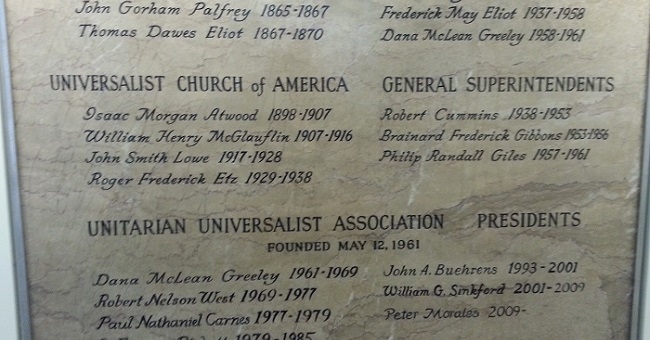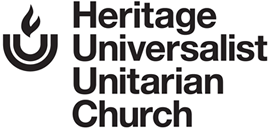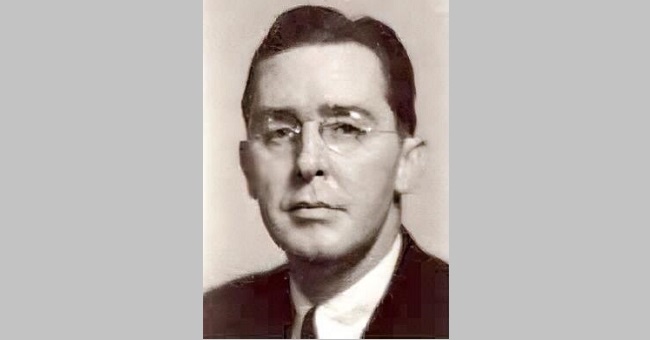The Stories of 42 Ministers Who Have Served Our Church
by Mike Roberts, Church Historian
As we continue our review of our past ministers, be reminded that near the turn of the century, led by minister Ulysses Milburn, our congregation had moved into a beautiful new facility in Walnut Hills. Milburn resigned near the completion of the church building and was quickly replaced by Reverend Harry Blackford.
Harry Blackford
Blackford was born in 1866 in the small Preble County town of Eldorado. His father was a Universalist minister and Eldorado, despite its size of only 350 residents, was a hotbed of Universalist activity. It had even hosted a state convention. After his ordination in 1892, Blackford served in Monson, Massachusetts and from there came to Cincinnati. He served only two years and while in Cincinnati enrolled in medical school. He did so to better care for his invalid wife, Lida. Upon completion of his medical studies, he took up his second career but lived only until 1908 when he died at the age 41. Ironically, his invalid wife outlived him by 30 years, passing away in 1938.
Samuel Gilbert Ayres
Samuel Ayres came to our church at age 33. He had one previous pastorate in a small town in western New York. He stayed in our pulpit for six years. During that time, the church was settling into its new Walnut Hills home. A report from Reverend Ayres in January of 1905 iterates a familiar theme—financial difficulty and lack of attendance by the membership but the congregation seemed to be settling into its new neighborhood.
Ayres left Cincinnati in 1909 to serve ten years in Woonsocket, Rhode Island. It is at this time that he took on the role for which he is most remembered. He was named Superintendent of the Universalist Mission in Yokahama, Japan. He and his wife, Minnie, ran the mission for six years, offering refuge for orphans and girls destined to service in the Geisha industry. Mrs. Ayres described their activities as more service and social relations to the Japanese population. In a monthly newsletter, Ayres described their efforts in trying to establish friendships with the people despite the closed nature of Japanese society. In 1923, Yokahama was hit with a 7.9 earthquake that did massive damage to the city and the mission. Much of the Ayres’ effort in their last two years was spent helping to rebuild both. Upon their return to the U. S., Rev. and Mrs. Ayres spent three years promoting the mission and traveling extensively to tell the story.
Samuel returned to the pulpit in 1930, serving several New England congregations. He died in 1955.
Anthony Bevis Beresford
Beresford succeeded Samuel Ayres to the pulpit. He had served the previous ten years as minister in Baltimore, Maryland. He was born in Detroit, Michigan in 1866, the son of immigrants from Bohemia. His father ran a butcher shop.
Beresford remained in our pulpit for 11 years, at the time the longest serving minister in the church’s history. His sermons were regularly reprinted in Cincinnati newspapers and are readily available at the public library website. Prior to WW I, he was a staunch supporter of President Wilson’s attempts to keep us out of war. Once we entered the war, his sermons often focused on the catastrophic loss of life and how it conflicted with our church’s view of a universal brotherhood of man. During the war, he served on the Patriotic Board of Instruction in Cincinnati. Both his sons served in the war and one was wounded in France.
After leaving Cincinnati in 1920, he returned to the Detroit area, serving the church in Farmington, Michigan. He later returned to Cincinnati as minister at the Mohawk Presbyterian Church. He died of a cerebral hemorrhage at his son’s home in 1940. He is buried in Spring Grove Cemetery.
Harold Guy Don Scott
Reverend Scott began service to our church at age 27 in 1920. He came from St. Johnsbury, Vermont. He had been ordained as a Unitarian minister in Old Town, Maine. Scott’s tenure at the Essex Street Church was brief, staying but one year in the pulpit. Evidently questioning his path, he left the ministry to work for the A. Nash Company, a clothing manufacturer in the city. Its owner, Arthur Nash, was a former minister who had left that profession, strongly protesting the hypocrisy of organized religion. Nash did, however, accept an invitation to speak at our church in support of Reverend Beresford’s concern over the loss of life in WW I. Nash went on to become a highly successful businessman while basing his management strictly on the tenets of the Golden Rule. His is a fascinating story but, unfortunately, beyond the scope of this discussion.
Reverend Scott returned to the ministry in 1926 and went on to serve 11 different churches and also served as a sociology professor at Colorado State University. He died in 1965.
John Edwin Price
John Price was ordained at age 23 and served his first church in 1917 in Winthrop, New York. He came to the Queen City in 1922 and ministered for five years. He felt his greatest accomplishment was establishing a nondenominational education program that offered course work free of charge. In reminiscing about his term in Cincinnati, he remembered when “parents were presenting their babes to be dedicated to the pursuance of Christian truth; when older ones took their stand for Christ and the larger faith; when different couples had sought the church’s blessing on the sacred union of their hearts and when we stood about a then lonely, now sacred plot of ground repeating the affirmations of faith which alone are sufficient in such an hour.”
Price left the ministry in 1927 when he was offered the opportunity to edit a new periodical being started by local business man Arthur Nash. This is the same Arthur Nash who spoke at our church during WW I and hired Price’s predecessor at the church. Nash obviously had a close relationship with our church although it is unknown if he was a member. Perhaps further research could discover the depth of that relationship. Price continued as a highly successful editor for the remainder of his work life eventually serving as editor in chief at the Maywood Syndicate Publishing House in New York. He died in Sydney Center, New York in 1973.
Robert Cummins
Robert Cummins was one of the most successful of all the ministers who have served our church. He was raised in Sidney, Ohio, graduated from Miami University in 1919 and then served several years as a missionary in Bangkok, Thailand. After returning to the U.S., he was ordained in 1926 and accepted a ministry that had him serving three churches in Milford, Newtown and Montgomery. He then took the pastorate in our church in 1928 at the age of 31. He served four years here and then moved on to Throop Universalist Church in Pasadena, California. His term here was spent mostly during the early stages of the Great Depression and financial challenges of maintaining a church occupied many of his efforts along with supporting many members who found themselves suddenly in dire need.
After five years in Pasadena, Cummins was chosen as the General Superintendent of the Universalist Church of America, a position he held for 16 years. During that period, he attempted on numerous occasions for the Universalist Church to be accepted into the Federal Council of Christian Churches. His efforts always were turned away by the council and this led him to first explore the idea of a merger with Unitarianism. His first mention of this came as early as the mid-1940s and Cummins was always one of the leaders who finally forged the merger of the two churches.
Cummins service as superintendent ended after 16 years when he accepted the challenge of working for the U.S. Department of State, heading the International Cooperation Administration during the Eisenhower administration. He finished his career in religious leadership by serving as President of the Maine Universalist Association. He passed away in 1982 in Brunswick, Maine. His son, John, became a highly respected UU minister, serving a church in Minneapolis, Minnesota for much of his adult life.

Top image: Rev. Robert Cummins.
Top image from Parish Practice in Universalist Churches, by Robert Cummins, via Caute — Making Footprints Not Blueprints.

